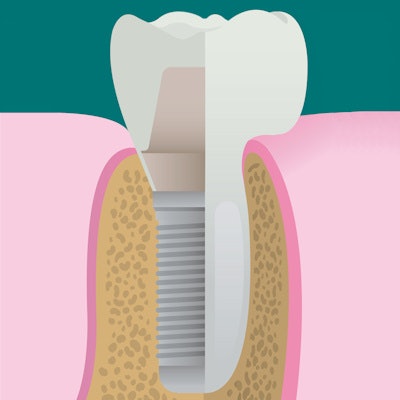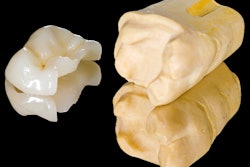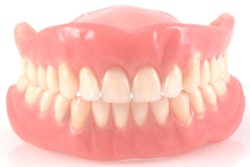
What's the effect of implant-supported single crowns or fixed partial dentures on oral health-related quality of life, and is this effect influenced by age or gender? A new study examined both physical and psychological factors in patients up to three years after implant placement.
Researchers asked partially edentulous individuals to complete a questionnaire on oral health-related quality of life before and after implantation. The results indicated significant improvements overall and in various quality of life factors, all of which grew over time, as well as some differences based on age.
"Scores demonstrated the significant increase in the oral health-related quality of life after the therapy, which suggested increased levels of patient satisfaction," wrote study author Bader Alzarea, an associate professor in the department of prosthetic dental sciences at the Al Jouf University College of Dentistry in Sakakah, Saudi Arabia (Journal of Clinical and Experimental Dentistry, May 1, 2017, Vol. 9:5, pp. e666-e671).
Increased satisfaction
Removable and fixed partial dentures have been available in the past as treatments for edentulous patients, but more recently implant therapy has provided another option. Prosthodontists tend to consider implant endurance, prosthesis durability, and recurrence of complex problems as important implant results, although social and psychological effects of treatment, cost, and treatment utility are more important for patients, according to the study author.
“Scores demonstrated the significant increase in the oral health-related quality of life after the therapy, which suggested increased levels of patient satisfaction.”
Oral health-related quality of life is an essential patient-focused end point to consider, Alzarea wrote. Many studies have measured this quality of life for conventional prosthodontic therapy, but few have examined it after implant therapy. However, some studies have noted enhanced quality of life with implant-supported removable overdentures with the use of complete dentures.
Only minimal data are available on oral health-related quality of life in patients treated with implant-supported single crowns or fixed partial denture, the author wrote. Therefore, he undertook the current study to examine this issue.
The study included 79 healthy, partially edentulous adults who ranged in age from 39 to 81 years who underwent implant treatment in the prosthodontics department at the Al Jouf University College of Dentistry from August 2013 to June 2016. They all received ITI Dental Implant System titanium implants (Straumann), which were restored with single crowns or fixed partial dentures.
Before implant placement, each patient completed the Oral Health Impact Profile (OHIP), a 49-question measure of oral health-related quality of life. They also filled out the questionnaire one, two, and three years after implant placement. With the OHIP, lower scores mean higher quality of life.
Among the patients, 47 were male with a mean age of 46.1 ± 10.18 years, and 32 were female with a mean age of 43.5 ±11.9 years. A total of 232 implants were placed, with a maximum of 34.91% at premolar teeth, 34.05% molar, 21.12% incisors, and 10.78% canines. Three implants were placed in 26.58% of the patients, two in 22.78%, one in 18.99%, and six or more in 6.33%.
Results of the OHIP indicated a significant decrease between baseline and one year after implant placement in all the variables measured except for handicap. The variables with significant improvements were functional limitation, physical pain, psychological discomfort, physical disability, psychological disability, and social disability.
All the variables, including handicap, significantly decreased between baseline and after two years and three years.
| Mean OHIP scores at various times | ||||
| Before implantation | After 1 year | After 2 years | After 3 years | |
| Functional limitation | 17.1 | 10.12 | 8.03 | 5.76 |
| Physical pain | 16.3 | 11.5 | 6.20 | 4.12 |
| Psychological discomfort | 10.76 | 6.12 | 3.64 | 2.36 |
| Physical disability | 9.12 | 5.98 | 2.58 | 1.90 |
| Psychological disability | 8.96 | 5.76 | 2.52 | 1.79 |
| Social disability | 5.49 | 2.83 | 1.97 | 1.16 |
| Handicap | 3.24 | 2.16 | 1.11 | 0.61 |
| Total | 70.97 | 44.47 | 20.50 | 17.70 |
The results suggest improved quality of life in these partially edentulous patients after they underwent implant treatment. These findings agree with previous studies that found improved quality of life in patients with implant fixed partial dentures, the author noted.
Examining subgroups, he didn't find any differences in OHIP scores between men and women measured at any time. Mean scores were the same at baseline among those older than and younger than 60 years, but they were significantly lower at one, two, and three years after treatment in the older group compared with the younger one. This indicated greater improvements in quality of life in the older group.
| OHIP scores by age | ||||
| Before implantation | After 1 year | After 2 years | After 3 years | |
| Younger than 60 years | 72.63 | 48.32 | 29.71 | 21.68 |
| Older than 60 years | 69.01 | 40.51 | 11.28 | 13.72 |
These differences by age were similar to the results of previous studies. The younger patients were more likely to work and needed to adapt to various social circumstances, and they may have had greater oral health needs compared with the older patients, the author noted.
Time after time
The patients were not asked to complete the OHIP until one year after treatment, as a shorter time period may not have been long enough to completely demonstrate the benefit of prosthodontic therapy, the author explained. Additionally, patient follow-up over a period of years may better assess the treatment's long-term effects.
Overall, the results indicated improving levels of patient satisfaction over time.
"The pre- and post-treatment OHIP summary and subscale scores of patients demonstrated a significant decrease in OHIP scores, which described the significant increase in oral health-related quality of life after the therapy, which suggested increased levels of patient satisfaction," the author wrote.



















